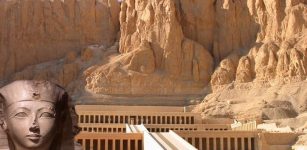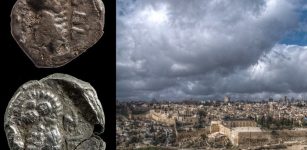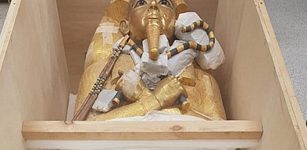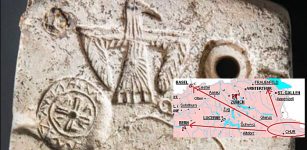Thermopolium – Ancient Roman Restaurant Offered Fast Food But Was It A Good Idea To Eat There?
Ellen Lloyd - AncientPages.com - In modern times fast food has become popular because many simply don’t have time or energy to prepare a proper meal. Ancient Romans loved delicious food, but they could occasionally skip dinner preparations and eat fast food.
Thermopolium was an ancient Roman restaurant which offered its customers fast food. One could get warm meals, as well as drinks. People who were hungry could visit a thermopolium and get something to eat fast.
Ruins of a thermopolium discovered in Pompeii. Credit: Public Domain
The word thermopolium (plural thermopolia) comes from Greek and means literally "a place where (something) hot is sold".
A typical thermopolium had L-shaped counters into which large storage vessels were sunk. Eating outside was something people enjoyed because it was considered an important aspect of socializing.
In a thermopolium people could get cheap meals. Fish or cheese with bread was often served. As dessert, hungry people could get honey and later drink spicy wine.
It may sound like a good place to visit, but a thermopolium had its advantages and disadvantages. Thermopolium was a place mainly for poor people. The advantage with serving this kind of fast food was that everyone could eat. Not everyone Roman had the time or possibility to cook at home. Many poor Romans could not afford a private kitchen.
A thermopolium in Pompeii. Credit: Wikipedia
The disadvantage was that many who visited a thermopolium became drunk and neglected their duties.
People from the upper-class in ancient Rome had a low opinion of those who visited a thermopolium, a place they associated with vagrancy.
See also:
Hypocaust – First Central Heating Invented By Ancient Romans 2,000 Years Ago
What Was Legio Martia And Why Were The Roman Soldiers Called The Martians?
Ancient Romans Loved White Teeth – All Means Were Acceptable To Get Them Even Portuguese Urine
Archaeologists have uncovered several well-preserved ruins of thermopolia in Pompeii and Herculaneum.
A thermopolium was L-shaped and mostly visited by poor people who couldn't afford a private kitchen. Credit: Wikipedia
The Thermopolium of Asellina, in Pompeii has given historian an excellent opportunity to study forerunner of today's restaurant. At the site, archaeologists discovered an almost perfectly preserved thermopolium. Complete jugs and dishes were found on the counter, as well as a kettle filled with water. Archaeologists working at the site also found a jar full of coins, amounting to about two days' income.
The thermopolium, one of the best-preserved sites in Pompeii, has long been closed to the public, but in 2010, after proper restoration this ancient snack bar of the Roman Empire re-opened.
Those who visit the Thermopolium of Asellina can get a sample of baked cheese with honey, just like poor ancient Romans did before the entire city of Pompeii was buried under masses of volcanic ash when Mount Vesuvius erupted August 24, 79 AD.
Written by Ellen Lloyd – AncientPages.com
Copyright © AncientPages.com All rights reserved. This material may not be published, broadcast, rewritten or redistributed in whole or part without the express written permission of AncientPages.com
More From Ancient Pages
-
 Did Etruscans Solve The Mystery Of Synchronicity And The Secret Language Of The Stars?
Ancient Mysteries | Jul 5, 2018
Did Etruscans Solve The Mystery Of Synchronicity And The Secret Language Of The Stars?
Ancient Mysteries | Jul 5, 2018 -
 Three Roman Shipwrecks Discovered Off Tunisian Coast – One Is 2,000-Year-Old
Archaeology | Jun 9, 2023
Three Roman Shipwrecks Discovered Off Tunisian Coast – One Is 2,000-Year-Old
Archaeology | Jun 9, 2023 -
 Antediluvian Discoveries In Britain, Germany And France That Could Re-Write History
Ancient Mysteries | Jan 4, 2019
Antediluvian Discoveries In Britain, Germany And France That Could Re-Write History
Ancient Mysteries | Jan 4, 2019 -
 Ancient Chinese Tai Chu Calendar Was Defined By Emperor Han Wu
Ancient History Facts | Jun 3, 2019
Ancient Chinese Tai Chu Calendar Was Defined By Emperor Han Wu
Ancient History Facts | Jun 3, 2019 -
 Climate Played A Crucial Role In Human Migration From Africa – New Study
Archaeology | Dec 8, 2023
Climate Played A Crucial Role In Human Migration From Africa – New Study
Archaeology | Dec 8, 2023 -
 Pharaoh Hatshepsut: Skillful And Efficient Female Ruler Who Brought Prosperity To Ancient Egypt
Featured Stories | Mar 22, 2017
Pharaoh Hatshepsut: Skillful And Efficient Female Ruler Who Brought Prosperity To Ancient Egypt
Featured Stories | Mar 22, 2017 -
 Rare 2,700-Year-Old Seal Of Biblical King Jeroboam II’s Servant Confirmed Authentic
Artifacts | Jan 18, 2021
Rare 2,700-Year-Old Seal Of Biblical King Jeroboam II’s Servant Confirmed Authentic
Artifacts | Jan 18, 2021 -
 Extremely Rare And Tiny Biblical Coins Discovered Near The Temple Mount
Archaeology | May 30, 2018
Extremely Rare And Tiny Biblical Coins Discovered Near The Temple Mount
Archaeology | May 30, 2018 -
 Mystery Of The Second Gabriel Stone And The Man Resurrected By Archangel Gabriel
Biblical Mysteries | Sep 10, 2018
Mystery Of The Second Gabriel Stone And The Man Resurrected By Archangel Gabriel
Biblical Mysteries | Sep 10, 2018 -
 King Tutankhamun’s Large Golden Coffin Was Moved For Restoration
Archaeology | Jul 18, 2019
King Tutankhamun’s Large Golden Coffin Was Moved For Restoration
Archaeology | Jul 18, 2019 -
 10th Century Sculpture Of Sun God Surya Accidentally Found In Farmland In Andhra Pradesh
Archaeology | Nov 16, 2020
10th Century Sculpture Of Sun God Surya Accidentally Found In Farmland In Andhra Pradesh
Archaeology | Nov 16, 2020 -
 Puzzling Construction Of Unique Sunken Ship From The 17th Century Examined
Archaeology | Jul 28, 2022
Puzzling Construction Of Unique Sunken Ship From The 17th Century Examined
Archaeology | Jul 28, 2022 -
 Challenging Prehistoric Gender Roles – Women Were Hunters Too – Not Just Men
Archaeology | Oct 21, 2023
Challenging Prehistoric Gender Roles – Women Were Hunters Too – Not Just Men
Archaeology | Oct 21, 2023 -
 1,000-Year-Old Multi-Shaped, Double-Sided Mold For Jewelry Found In Swiss City Of Chur
Artifacts | Jul 26, 2020
1,000-Year-Old Multi-Shaped, Double-Sided Mold For Jewelry Found In Swiss City Of Chur
Artifacts | Jul 26, 2020 -
 Suprising Discovery Of A Well-Preserved Ancient Roman Road In London, UK
Archaeology | Nov 19, 2024
Suprising Discovery Of A Well-Preserved Ancient Roman Road In London, UK
Archaeology | Nov 19, 2024 -
 Locations Of 11 Lost Ancient Cities Revealed On 4,000-Year-Old Artifacts
Archaeology | Nov 15, 2017
Locations Of 11 Lost Ancient Cities Revealed On 4,000-Year-Old Artifacts
Archaeology | Nov 15, 2017 -
 Enigma Of The Mysterious Ancient Shining Twins – The Cosmos Connection – Part 2
Ancient Mysteries | Jun 8, 2020
Enigma Of The Mysterious Ancient Shining Twins – The Cosmos Connection – Part 2
Ancient Mysteries | Jun 8, 2020 -
 Stunning CGI Reconstruction Of Saint Thomas Becket’s Shrine
Archaeology | Jul 7, 2020
Stunning CGI Reconstruction Of Saint Thomas Becket’s Shrine
Archaeology | Jul 7, 2020 -
 Ice Age Mystery – Unexplained Disappearance Of North America’s Large Mammals – New Clues
Fossils | Jun 1, 2024
Ice Age Mystery – Unexplained Disappearance Of North America’s Large Mammals – New Clues
Fossils | Jun 1, 2024 -
 Atacama Desert Reveals More Ancient Secrets
Archaeology | May 8, 2018
Atacama Desert Reveals More Ancient Secrets
Archaeology | May 8, 2018



